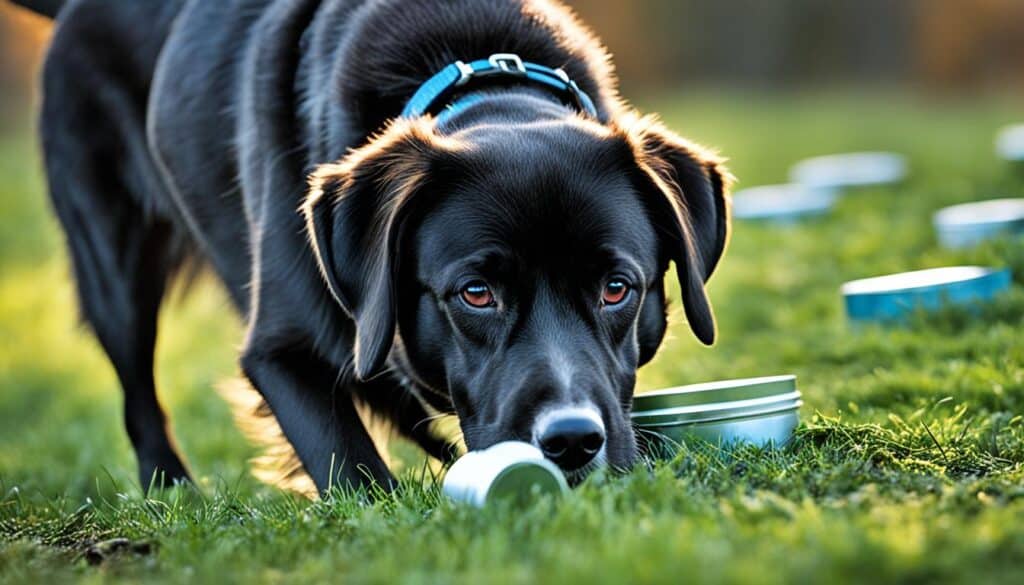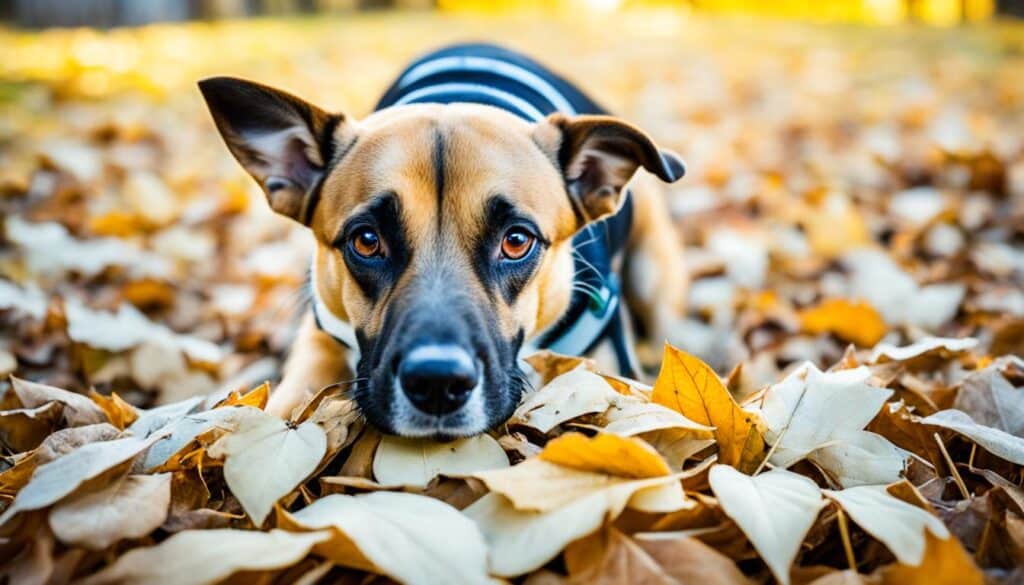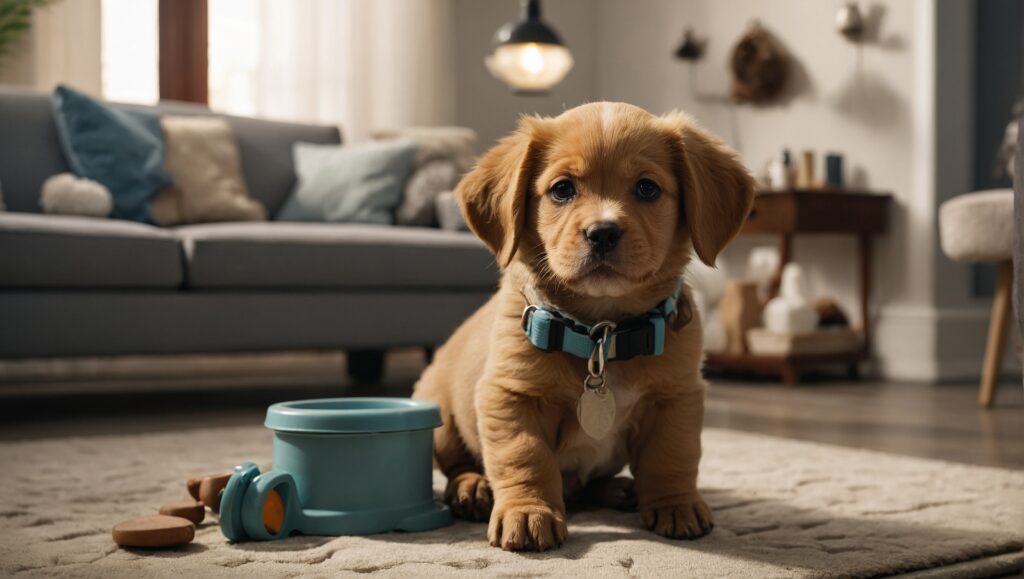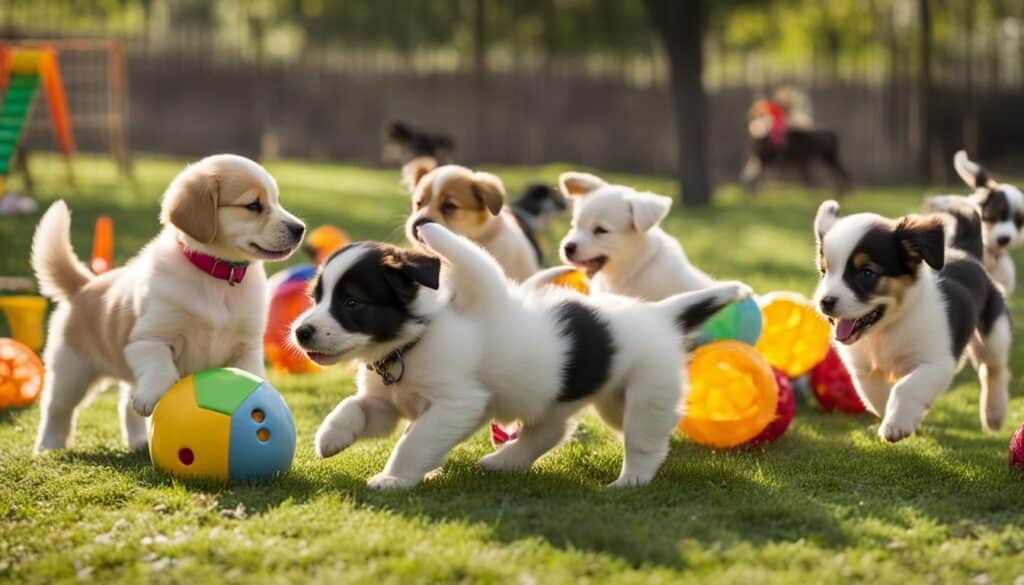Welcome to our step-by-step guide to dog nose work. Here, we dive into the fascinating world of canine scent detection training. If you’ve ever wondered at your dog’s unique sense of smell, you’re in for a treat. With the proper training, your dog can achieve remarkable things. Dog nose or scent work is both fun and mentally stimulating. Plus, it’s like a game your dog will love.
This guide will get you ready for dog nose work. We’ll start by explaining the basic principles. Then, we’ll help you pick your pup’s perfect nose work class. Finally, we’ll list the supplies you need. Whether you’re a pro at dog training or just starting, we have all the info you need. Let’s get ready to explore the exciting world of dog scent work!

Key Takeaways:
- Dog nose work is a fun and engaging activity that taps into your dog’s instincts and provides mental stimulation.
- Understanding the basics of scent work is essential for effectively training your dog in nose work.
- Choosing the appropriate nose work class and gathering the necessary supplies are crucial for your dog’s success.
- Incorporating daily scent games and using rewards help boost your dog’s skills and keep training fun.
- Advancing beyond the basics of nose work involves introducing more complex scents and challenges and preparing for competitions.
Getting Started with Dog Nose Work
Starting dog nose work is critical to entirely using your dog’s keen sense of smell. This guide will show you the essentials. You’ll learn about dog scent work basics and how to pick the best class for your pup. We’ll also suggest the must-have supplies to kickstart your scent work adventure.
Understanding the Basics of Dog Scent Work
In dog scent work, dogs engage their powerful sense of smell. This not only rewards them but also keeps their minds active. Since dogs naturally explore the world through smell, scent work uses their instincts to excellent effect.
Grasping the basics of scent work is vital for your dog’s training. Knowing how dogs smell and how scent works benefits them and makes training your furry friend easier. This knowledge can make your dog’s scent journey more fun and successful.
Choosing the Right Nose Work Class for Your Dog
Choosing a suitable nose work class means thinking about a few things. Look at your dog’s age, breed, and what they’re like. It’s also about your specific training goals. Make sure the instructor you pick knows about scent work.
Your instructor will play a significant role in how well your dog learns. A good instructor will recognize what your dog can do and help you both learn in a fun, safe way.
The Essential Supplies You Need to Begin
Starting nose work means having the right stuff. You’ll need scent containers, treats, and training tools. These items are essential to train your dog to find specific scents. They make learning practical and fun.
Having the right supplies makes teaching your dog scent work easier. They help your dog learn to search for and recognize smells. Starting with the right supplies prepares your dog for more advanced scent work.
The items you need for dog nose work includes scent containers, training tools, and treats. These items make training enjoyable and effective.
The Fundamentals of Training Your Dog in Nose Work
Introducing Your Dog to Different Odors
Training your dog for nose work begins with teaching them about different smells. This improves their ability to track and identify the odors they are looking for. You can use birch, anise, and clove smells for this. These smells are safe and easy to get for training. Put some scent on a cotton swab or in a particular container. Let your dog smell it, and then reward them. Do this a few times to help your dog link the smell with a good thing.

Teach Your Dog the Basics of Find and Alert
After your dog knows the smells, start with finding and alerting the basics. You will teach your dog to look for the scent and then show you they found it. Dogs can indicate the smell in two ways. They may sit near it (passive indication) or do something like bark if they find it (active indication).
Decide which method is best for your dog and start training. At first, hide the smell in an accessible place for them to find. When they see it, give them a treat and praise. Make finding the smell harder as your dog improves. This keeps them challenged and sharpens their detection skills.
Transitioning from Training to Actual Searches
Once your dog has the training basics, move to search in real places. Start indoors where it’s simple and quiet. Try more challenging places like the backyard or new areas as they get better. This trains your dog to search in all kinds of places. During searches, use clear signs to guide your dog. Always reward them when they succeed. More practice in different locations makes your dog a better nose worker.
| Fundamentals of Training Your Dog in Nose Work | Steps |
| Introducing Your Dog to Different Odors | 1. Choose common scents like birch or anise. 2. Associate the scent with a positive reward. 3. Repeat the process to establish the connection. |
| Teach Your Dog the Basics of Find and Alert | 1. Choose passive or active indication technique. 2. Hide the odor and encourage your dog to search. 3. Reward them for finding and alerting them to the scent. |
| Transitioning from Training to Actual Searches | 1. Practice indoors in controlled environments. 2. Gradually progress to more challenging locations. 3. Keep providing cues and rewards during actual searches. |
Nose Work Training Classes: What to Expect
Choosing the Right Instructor for You and Your Dog
Choosing the best nose work instructor is vital for your and your dog’s success. Look for someone skilled in canine scent work. They should have a good track record of helping dogs and their owners reach their training goals.
Ensure their teaching style matches your training philosophy and your dog’s needs. Take time to look into their background. Read reviews from other clients to learn about their methods and success rate.
The Structure of a Typical Nose Work Class
Nose work classes are carefully structured to help both dogs and handlers progress. The session starts with warm-up exercises. This gets the dog and owner ready for the training ahead.
Warm-ups can be stretching, relaxation techniques, or short training. All these help prepare for the scent detection work. Next, practice searches are done. Dogs get to know new scents, and their owners learn how to help them find these scents.
Searches can take place indoors or outdoors. These will get more challenging over time. The class ends with cool-down exercises. These are important for relaxing and looking back on the training. It can involve gentle stretching, massage, or quiet time between the dog and its owner.
How to Prepare Your Dog for Success in Classes
Getting your dog ready for nose work classes is crucial. Here are some tips:
- Make sure your dog is well-rested for each class. They need to focus on learning.
- Don’t feed them a big meal before class. It can make them sluggish.
- Exercising your dog before class helps burn off extra energy. This makes them better able to focus.
- Give them a bathroom break before the class to lessen distractions.
- Have treats ready. They’re great for positive reinforcement during training.
- Bring water and a bowl so your dog can stay hydrated.
Help Your Dog Excel in Nose Work
To make your dog great at nose work, include scent games in their daily routine. These games boost their smelling skills. They also keep dogs interested and excited. Understanding how rewards work and handling their frustration well is critical. This makes training both fun and effective.
Incorporating Daily Scent Games to Boost Skills
Daily scent games are perfect for improving your dog’s nose work. They make your dog more innovative and better at sniffing things out. You can start by hiding treats or toys at home. This makes your dog rely on their scent to find them. You should later make the games harder. You can hide things in more challenging spots or layering scents. Doing this regularly sharpens your dog’s sense of smell.

Understanding the Role of Rewards in Nose Work
Giving rewards is crucial in nose work. It helps your dog know when they’ve done something right. Use treats or praise when they find hidden scents. This keeps them eager to sniff out more. Rewards are also an excellent way to teach new skills. So, they improve your dog’s nose work over time.
Managing Frustration and Keeping Training Fun
Avoid letting your dog get too frustrated during training. It can spoil the fun and slow their learning. Watch their energy and give breaks as needed. Make learning enjoyable by adding play to sessions. This keeps your dog happy and interested in training.
Your dog can do well in nose work by mixing in scent games, knowing how rewards work, and handling frustration. Remember, being consistent and patient helps a lot. And always focus on making training suitable and fun for your dog.
Advancing Beyond the Basics of Nose Work
Introducing More Complex Scents and Challenges
After mastering essential nose work, it’s time to add a challenge. Introduce your dog to new scents like clove or thyme. Observe how they react and praise them when they do well. This positive feedback is crucial.
Next, up the game by hiding scents in trickier spots. Place scents in drawers, boxes, or outdoor spots. Mixing up how you hide scents keeps your dog sharp and adaptable.
Preparing for Nose Work Competitions
Dreaming of competitive nose work success? First, know the rules and what judges look for. Train with the hides and settings that mimic contest conditions.
To step up your game, introduce distractions gradually. Operating smoothly in diverse environments is a must. Your teamwork and bond with your dog are crucial to doing well in competitions.
Continuing Education for You and Your Canine Partner
Nose work is an ongoing journey for both of you. Stay informed about the newest training methods and research. Workshops and seminars are perfect for leveling up your skills.
This approach fine-tunes your training and helps you better understand scent work. Plus, it links you with like-minded experts keen on sharing insights.
| Advancing Beyond the Basics of Nose Work |
| Introduce more complex scents |
| Challenge your dog with difficult hiding spots |
| Prepare for nose work competitions |
| Practice with scent hides and search patterns |
| Work on handling distractions and improving teamwork |
| Continue educating yourself and your canine partner |
| Stay updated on training techniques and research |
| Attend workshops, seminars, and online courses |
Conclusion
Engaging in dog nose work is hugely rewarding for you and your dog. It shows how powerful a scent can be. You’ll deepen your bond with your dog by exploring their strong sense of smell.
Choose a good nose work class. Look for a skilled instructor in scent work. Also, make sure you have all the things you need to start. Introduce your dog to various smells and teach basic search and response skills.
To succeed in nose work:
- Play scent games with your dog daily.
- Learn how to use rewards effectively.
- Keep training sessions enjoyable and avoid getting frustrated.
Eventually, you can try more complex scents and more difficult challenges. Consider competing or attending workshops.

